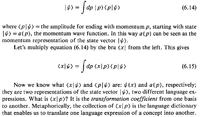Fractional-N
Full Member level 1

Hi,
I'm reading Goswami's book, "quantum mechanics",
I can't understand chapter 9 , "systems of two degrees of freedom"
it is said in page 122 that <x|p> is transformation coefficient from momentum basis to position basis
BUT
in chapter 9 , as it is shown in the pic below, it is said that <x|p> is equal to psi(x) !!! why?
I can't understand why equation (9.1) is correct ?

I'm reading Goswami's book, "quantum mechanics",
I can't understand chapter 9 , "systems of two degrees of freedom"
it is said in page 122 that <x|p> is transformation coefficient from momentum basis to position basis
BUT
in chapter 9 , as it is shown in the pic below, it is said that <x|p> is equal to psi(x) !!! why?
I can't understand why equation (9.1) is correct ?

Last edited:



